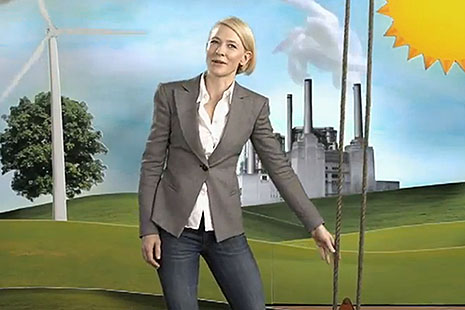THE simplest advertising trick is the non sequitur. Promoting something dull like banking? Use comedy. Selling junk food? Use sexy actors. Wanting to raise awareness of a complex issue? Employ a celebrity.
We celebrate celebrities – until we realise that they’re no humbler than the rest of us, and then the secateurs come out. Take Cate Blanchett, who turns out to have an opinion, alongside 90 per cent of the population, about climate change and how to respond. Blanchett is starring, free of charge, in an advertisement supporting a carbon tax, part of an estimated $1 million campaign cobbled together by groups such as Greenpeace, GetUp! and the ACTU.
Spying the opportunity for a populist attack to defend its rejection of a carbon price, the opposition responded by playing the woman, not the ball. News Ltd brought out its loud-hailers to sing along. The “Carbon Cate” headlines carried echoes of “Typhoid Mary” and “Tokyo Rose.” Suddenly, class envy was in vogue again, subtly communicated via images of Blanchett’s mansion alongside estimates of her wealth in bold type.
Sensing counter-outrage in its upmarket readership, the Fairfax press rode up to defend their Cate. Not unreasonably, it was pointed out that billionaires routinely gain airtime to opine about taxes and environmental policy. Isn’t it precisely the case that media owners use their wealth as a soapbox under the guise of “editorial freedom”?
Fretting about a high-profile actress’s “right to speak” is, however, beside the point. So, too, is whether Blanchett might, like Fairfax, be preaching to a limited group of converts. All that, as Lindsay Tanner would have it, is a sideshow. What really matters is the politics being conducted through duelling advertising campaigns. Is this constant massaging of political opinion a new phenomenon and is there any relief in sight?
Advertising by “third parties” – lobby and issue-based groups – is not new. As far back as 1973–74, Gough Whitlam’s Medibank and Government Insurance Office reforms confronted hefty campaigns financed by doctor’s organisations and insurance groups. The AMA alone assembled a $2 million fighting fund.
Nor are political campaigns on television new. Indeed, it was the Labor Party’s It’s Time campaign that ushered in the era of commercialised, saturation advertising promoting political causes. What has changed is the emergence of a tendency, first among governments and lately among third parties, to mount these campaigns at the drop of a policy hat, regardless of when an election is due. While they usually centre on a specific issue, the motivations behind these campaigns are more diffuse. The ultimate goal is to massage public opinion, and hence to reshape the landscape in which governments and MPs work.
In the late 1940s, the Labor prime minister Ben Chifley announced his momentous bank nationalisation policy late one evening in a short press release. For months, perhaps naively, his government focused on drafting the legislation rather than arguing its case in public. No one thought of raiding the budget to buy advertising space. The banks were cannier, and a subdued labour movement also responded, but even then their method was to recruit a bottom-up movement rather than buy a top-down campaign. Over the subsequent half-century the media paradigm has been inverted. The Keating government had the late Bill Hunter front its Working Nation campaign. The Howard government used Joe Cocker to implore us to “unchain our hearts” and embrace the GST.
Government advertising tends to be feel-good (“look how surprisingly decent our health/police/other services are!”) or reactive, designed to mollify antagonism towards troubled policies like Work Choices. Third-party campaigns pushing a positive agenda, such as the pro–carbon tax advertisements, are unusual. More common are those defending a well-defined self-interest, such as the unions’ anti–Work Choices campaign and the 2010 mining tax blitz. The success of these two mega-campaigns (costing around $20 million each) lay in their size and aggressiveness.
Tempered by public-sector guidelines, government campaigns must avoid direct partisanship and present positive, factual material. Third-party campaigns are untrammelled by such niceties. There is no requirement to avoid misleading the public and nor are there restraints on negative advertising. The pubs and clubs’ campaign against poker-machine reform is a good illustration: under the clichéd “It’s UnAustralian” banner, the industry has exaggerated and perhaps even lied by portraying the reform proposal as a “licence to punt.”
HOW should we, as a polity, respond? We might not regulate at all, and rely on our vigilant use of bullshit detectors. But that response risks inflating cynicism. Regulating content, as opposed to controlling the form or amount of political advertising, is theoretically an option, but a fraught one. Content is culturally, not legally, determined: no one has yet devised rules to foster informed deliberation. We could extend consumer protection rules to political advertising, at least to cover factual or descriptive claims that are materially misleading. An independent panel could then receive complaints. A few costly orders to pull and re-film material would encourage advertisers to err towards reasonable material.
Many see broadcast advertising as an inherently distorting medium – when it comes to public opinion, they believe, the medium is the message – and some people call for limitations that single out this form of media. For many years the British have banned paid political advertising on television; our High Court would not accept that. Apart from the potential to infringe the freedom of political communication, a more substantive difficulty with broadcast-centred regulation is that the very meaning of “broadcast” is fragmenting. Television’s dominance is disintegrating and the internet is not as ripe for regulation as commercial media oligopolies. For at least a few years to come, viral political advertising will present opportunities for aesthetic ingenuity, at least until the internet becomes more hierarchical and proprietorial.
The more typical regulatory model marries disclosure with expenditure limits. Australia really only has experience of disclosure. Under Howard government reforms, “political expenders” have been required, alongside parties and candidates, to disclose large donations. But this kind of disclosure often comes too late (generally well after an election) to be useful. Worse, disclosure on its own does nothing to tackle the risk unrestrained advertising poses to political equality, let alone deliberation.
Realising that, Britain and Canada also cap political-party and third-party expenditure. In Britain, the limit is around £1 million per third party during an election year. In Canada, the limit is much lower, close to A$200,000. New South Wales, in time for its recent election, and Queensland, in legislation about to pass, are also limiting large-scale campaigns on “state issues.” In New South Wales, for instance, a cap on “electoral communication expenditure” of just over $1 million statewide (including no more than $20,000 in any electorate) applied before the March 2011 state election. It’s likely that an all-party committee of the federal parliament, to report in September, will recommend a similar system for national elections.
In each case, the regulated period is not the whole of the parliamentary cycle but a window before an election is due. (In New South Wales it’s six months; in Queensland it will start once the parliament enters its third and final year.) This fails to recognise the emergence of the “permanent campaign,” assuming instead that election years are particularly prone to a spending arms race and that election campaigns should focus on the party and leadership contest more than on issue advertising. It also assumes government advertising will be modest before the caretaker period cuts in; if not, governments can swamp third parties as well as oppositions during the phoney campaign that tends to start several months before an election is called.
For a while, New Zealand borrowed the British system and capped election-year spending at NZ$120,000. But the National-led government recently repealed that cap, citing concerns about political freedom. While wealth should not act as a political bludgeon via the airwaves, concerns about communicative freedom are not mere abstractions. If caps are set too low, “front” organisations could proliferate. Or, as Andrew Norton argues, modest civic groups might unnecessarily be caught in the regulatory thicket.
The pact between the independents, the Greens and Julia Gillard promised comprehensive political finance reform. Designing comprehensible laws that balance the values of accountability and political equality without strangling civil society’s political voice will be a task in itself. And that’s without the juggling act involved in gaining cross-party agreement.
ASKED about Cate Blanchett and the carbon tax advertisements, Treasurer Wayne Swan said he admires people who speak out. In this instance, his principles and self-interest coincided. He also quipped that issue groups like GetUp! and Greenpeace had as much right to promote environmental concerns as mining companies had to use shareholder funds to fight taxes.
The language of rights is seductive. But it says something about the liberalism of modern Labor that the treasurer missed a deeper point. A campaign by a coalition of democratically organised groups, giving modest voice to the values of their memberships, must surely be less of a concern for Australia’s democratic system than a campaign financed by corporate interests. Sectoral campaigning by corporations – and for that matter unions or governments seeking to entrench their institutional power – is relatively unaccountable. Compared to Cate, their coffers and self-interest are much deeper, and hence in greater need of regulation. •




